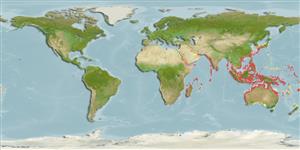Common names from other countries
Environment: milieu / climate zone / depth range / distribution range
Ökologie
seewasser riff-verbunden; tiefenbereich 0 - 25 m (Ref. 37816), usually 0 - 25 m (Ref. 37816). Tropical
Indo-West Pacific: Red Sea and East Africa to Fiji, north to southern Japan, south to Australia.
Size / Gewicht / Alter
Maturity: Lm ? range ? - ? cm
Max length : 17.0 cm TL Männchen/unbestimmt; (Ref. 5463)
Rückenflossenstacheln (insgesamt) : 5; Rückenflossenweichstrahlen (insgesamt) : 17 - 22; Afterflossenstacheln: 0; Afterflossenweichstrahlen: 17 - 22; Wirbelzahl: 32 - 33. Color variable (from brown to pink or yellow) with small black and white spots; 2 elongate black spots between first 3 dorsal spines (Ref. 4263). Total body plates 27-35. Caudal fin truncate, rounded, or lanceolate. Caudal peduncle short or lost in large females (Ref. 48635). Pelvic fin sexually dimorphic, forming a brood pouch in females (Ref. 9829).
This uncommon species is found in coastal reefs and weedy areas (Ref. 5463) or lagoon reefs, often on algal flats or seagrass beds (Ref 90102). Monogamous, always in pairs (Ref. 52884). Females carry the eggs in their pelvic fins that are modified to form a brood pouch (Ref. 205). Feed on small crustaceans (Ref. 1602).
Life cycle and mating behavior
Maturities | Fortpflanzung | Spawnings | Egg(s) | Fecundities | Larven
Monogamous mating is observed as both obligate and genetic (Ref. 52884).
Orr, J.W. and R.A. Fritzsche, 1993. Revision of the ghost pipefishes, family Solenostomidae (Teleostei: Syngnathoidei). Copeia 1993(1):168-182. (Ref. 9829)
IUCN Rote Liste Status (Ref. 130435)
CITES (Ref. 128078)
Not Evaluated
Bedrohung für Menschen
Harmless
Nutzung durch Menschen
Fischereien: nicht kommerziell; Aquarium: Öffentliche Aquarien
Tools
Zusatzinformationen
Download XML
Internet Quellen
Estimates based on models
Preferred temperature (Ref.
115969): 22.1 - 29, mean 27.8 (based on 1498 cells).
Phylogenetic diversity index (Ref.
82804): PD
50 = 0.5312 [Uniqueness, from 0.5 = low to 2.0 = high].
Bayesian length-weight: a=0.01000 (0.00244 - 0.04107), b=3.04 (2.81 - 3.27), in cm Total Length, based on all LWR estimates for this body shape (Ref.
93245).
Trophic level (Ref.
69278): 3.8 ±0.50 se; based on food items.
Fishing Vulnerability (Ref.
59153): Low vulnerability (10 of 100).
